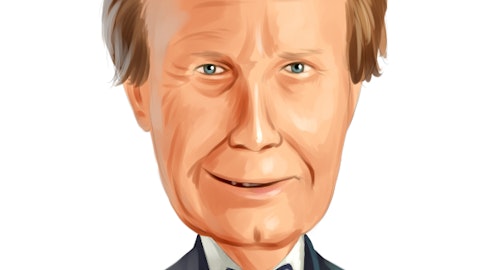Pete Vogt : Yes. A couple of things to make sure we clarify there. The losses are all associated with 2022 accident year. And it’s primarily associated with the seventh wave of COVID outbreak that happened in the early summer in Japan. We have some Japanese cedents where we provide a catastrophe XOL for A&H. So these are basically per diem hospitalization benefits and it’s a straight simple indemnity benefit. But with the regulatory change there where if you were at home under the careable position it was at “deemed hospitalization” our cedent saw a real spike in these per diem costs and it actually started to hit their cat XOL layers. So that’s what it’s associated with. It’s a handful of clients that we have in Japan and we have no other contracts like that in the area. So we’re not exposed to other countries.
Yaron Kinar : Got it. And again, enjoy retirement Albert, and good luck to Vince and the rest of the team.
Albert Benchimol: Thank you.
Operator: Thank you. And the next question comes from Elyse Greenspan with Wells Fargo.
Elyse Greenspan: Hi. Thanks. Good morning. You guys pointed to looking at the insurance right attritional full year loss ratio, which I think was just under 51% as thinking about go-forward modeling. You also right mentioned pricing of 6% in insurance in the fourth quarter. I’m not sure where the current view of loss trend is. But when you think about pricing and loss trend, how should we think about the level of improvement you could see from that 51% baseline in insurances in 2023?
Albert Benchimol: Well, I think, as you pointed out, we have 9% average for the year, 6% in the quarter. But to be fair, we are taking a prudent view on loss trends and inflation. So we think it’s in the mid single digits, so there’s opportunities for improvement, but not massive. But I think the book is in a really good place now. To be fair, we’re delivering this year a sub-90 combined ratio. We think the book is where we want it to be. The goal for us frankly is to write more. At these margins, I mean, it’s really — growth is very accretive for us. So we feel positive about the book that we have the premiums that we earn as I said are basically at or ahead of loss costs. And the goal here is to keep the book where it is and grow.
Elyse Greenspan: Okay. And then in terms of debt when you guys typically look at debt to prefer to total capital right still above 30%. Is the goal still to get that to the mid-20s? And is that a level that you need to see to think about capital return?
Pete Vogt : Yes. Elyse, this is Pete. I think as we continue to evolve more into an insurance specialty where we don’t necessarily need to have as low a ratio that — we’re going to look to get that ratio, I’d call it to the mid- to high 20s. And I don’t think we need to exactly be there to have any opportunistic plays of what we want to do with capital, but we are looking to get it below 30% and I would like to see it get into the mid- to high 20s. But before we do, we’re probably talking about the share repurchase program. I’d like to actually see the capital those ratios get below 30%. But I don’t think we need to get all the way to 25%, but I’d like to be comfortably in the mid to high 20s.
Albert Benchimol: Yes. I’d add a couple of comments to that. I think the mid-20s is a good number for a reinsurer with volatile results. I think the kind of company we are. I think if you look at specialty peers, they can afford a higher leverage. But the other thing that I would point to is, as you know the increase in the leverage ratio came only because of the market value of the bonds and given our high-quality portfolio in three-year duration we think there’s a significant amount of opportunity for book value growth and leverage reduction simply with the return to par of the bonds that we have in our portfolio.
Elyse Greenspan: And then you guys have — we’ve seen the PMLs come down at most return periods. I did notice the Japan windstorm PML did go up a little bit in the quarter. What’s going on there?
Pete Vogt: Hey, Elyse this is Pete, I’ll handle that. At year-end we had some of our third-party capital partners. Those are calendar year contracts. And so some of the protection on the property book for reinsurance ended at 12/31 and then the Japanese renewals happened April 1. So, you will see those — those jumped up because we didn’t have that outwards protection on the reinsurance book from our third-party capital partners but it will come down again on April 1. Again it kind of leaves us exposed a bit on reinsurance if there happens to be a quake in Japan in the next 90 days. However, I’m not too worried about a typhoon in the next 90 days. But that’s what that was about. And you’ll see that adjust again as we get to April 1.
Elyse Greenspan: Thanks. Thanks for the color. Albert all my best to you in retirement as well. Thank you.
Albert Benchimol: Thank you.
Operator: Thank you. And the next question comes from Meyer Shields of KBW.
Meyer Shields: Thanks. I’m going to ask the same sort of question as Elyse, but maybe retrospectively. The press release didn’t attribute the insurance segment underlying loss ratio improvement to a gap between rate and trend. I’m wondering is that an accurate reflection of how you’ve been booking losses?
Pete Vogt: Hey Meyer, this is Pete. We’ve had some benefit of rate over trend. I just think in the quarter the predominant movement was because we had such good results coming out of those three areas due new experience. So, we are still seeing a little bit of rate over trend in the insurance segment but it did slowdown in the second half of the year and the predominant reason was I think those three lines of business really had good experience in the quarter.
Meyer Shields: Okay, that’s helpful. The second question so I think also Pete you’d emphasize that the loss portfolio transfer — sorry applies to product lines that are mostly exited. And I’m wondering if you could break down the reserve development on the professional lines and liability lines or products that you’re still in because we’ve seen the overall numbers but I’m wondering if there was a material difference in terms of how the exited product lines reserves have performed versus the ongoing longer term lines?
Pete Vogt: Hey, Meyer this is Pete. I had not planned on doing that. Again when we do our global loss triangles and we need to make any comment in that document about maybe exited lines we’ll think about maybe adding some color there. But I was not planning on trying to break those reserves out and do them separately for you. As we think about the GLTs, we’ll kind of take that advice under advisement and see what we can do to help you understand the ongoing book better.
Meyer Shields: Okay. My advice is worth what you paid and Albert best of luck.





